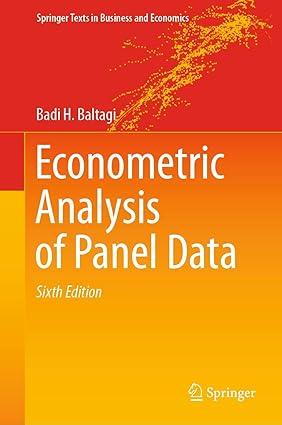Fixed Effects v.s. Omission of time-invariant variables. This is based on Oaxaca and Geisler (2003). Consider the
Question:
Fixed Effects v.s. Omission of time-invariant variables. This is based on Oaxaca and Geisler (2003). Consider the case where the fixed effects \(\mu_{i}=\) \(Z_{i}^{\prime} \pi\) are just omitted time-invariant variables made up of \(Z_{i}^{\prime} s\) which are of dimension \(1 \mathrm{xg}\). Note that this may include a constant, but unlike the Hausman and Taylor (1981) or Mundlak (1978) reduced form model, this does not include an error term. The true regression model in this case is \(y_{i t}=X_{i t}^{\prime} \beta+Z_{i}^{\prime} \pi+u\) with \(u \sim \operatorname{IIN}\left(0, \sigma_{u}^{2} I_{N T}ight)\). For this model, pooled OLS is BLUE, but the researcher omits the \(Z_{i}^{\prime} s\), and runs instead fixed effects to estimate \(\beta\). Oaxaca and Geisler (2003) show that the pooled OLS estimate of \(\pi\) can be obtained as a GLS of fixed effects residuals averaged over time (as in the Hausman-Taylor procedure, see (7.41)), i.e., \(\widehat{d}_{i}=\bar{y}_{i}-\bar{X}_{i .}^{\prime} \widetilde{\beta}_{F E}\) on \(Z_{i}\).
(a) Prove this result, and show that the resulting standard errors from the two regressions will be different due to the different estimates of the remainder variance \(\sigma_{u}^{2}\).
(b) Oaxaca and Geisler (2003) suggest a Chow F-test based on the difference between the restricted sum of squares from pooled OLS imposing the restriction \(H_{0}^{a} ; \mu_{i}=Z_{i}^{\prime} \pi\), versus the unrestricted sum of squares residuals obtained from the fixed effects regression. Note that this is different from the test for \(H_{0}^{b} ; \pi=0\), which can also be obtained from a Chow F-test based on the difference between the restricted OLS residual sum of squares of \(y\) on \(X\), versus the unrestricted OLS residual sum of squares of \(y\) on \(X\) and \(Z\). It is also different from the usual F-test for fixed effects, i.e., \(H_{0}^{c} ; \mu_{i}=0\) which was introduced in Chap. 2. The latter is based on the difference between the restricted sum of squares residuals from OLS of \(y\) on \(X\), versus the unrestricted sum of squares residuals obtained from the fixed effects regression.
Comment: The crucial assumption here is that \(\mu_{i}\) is a known function of the \(Z_{i}^{\prime} s\), which is restrictive, and unlike the Hausman-Taylor model, \(\mu_{i}\) can not be a function of some of the time varying variables, the \(X_{i t}^{\prime} s\), nor can it have a stochastic error term. This is why the second step in the Hausman-Taylor procedure is 2SLS and not GLS. In the HT model, the \(Z_{i}^{\prime} s\) are correlated with the individual effects, i.e., the \(\mu_{i}^{\prime} s\), because both of them appear in the regression model; see (7.40). Here, GLS is performed in the second step because it is assumed that the \(\mu_{i}^{\prime} s\) have been replaced by their known functional form \(Z_{i}^{\prime} \pi\).
![]()
![]()
Step by Step Answer:






